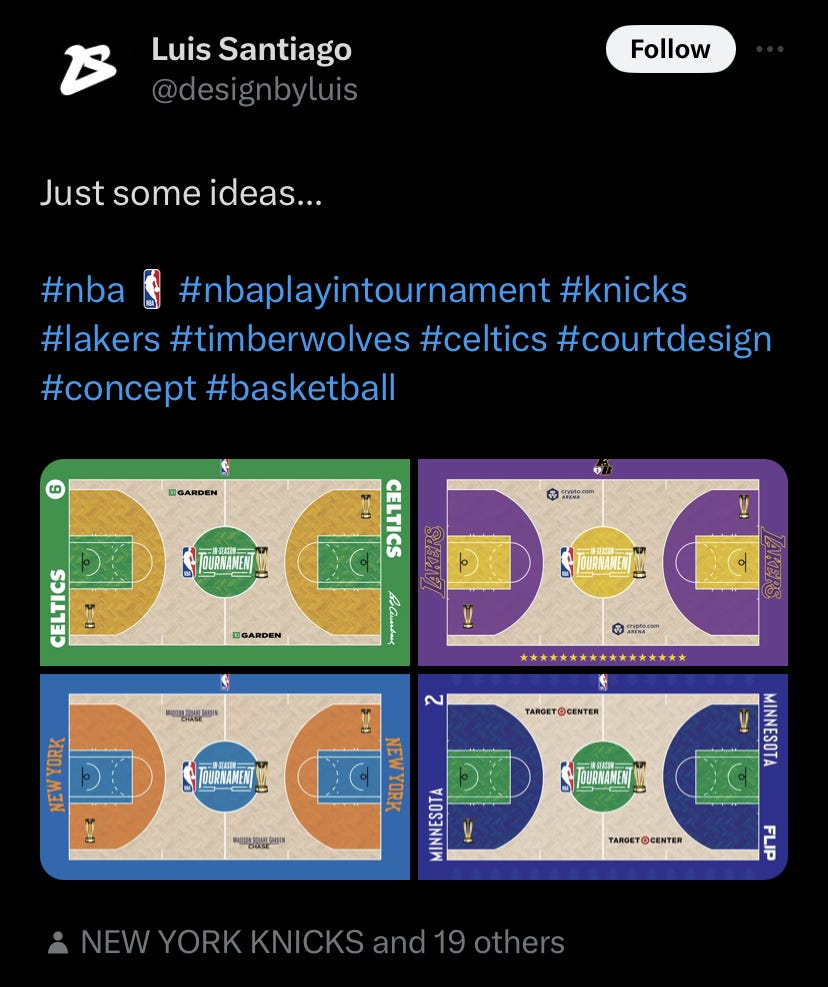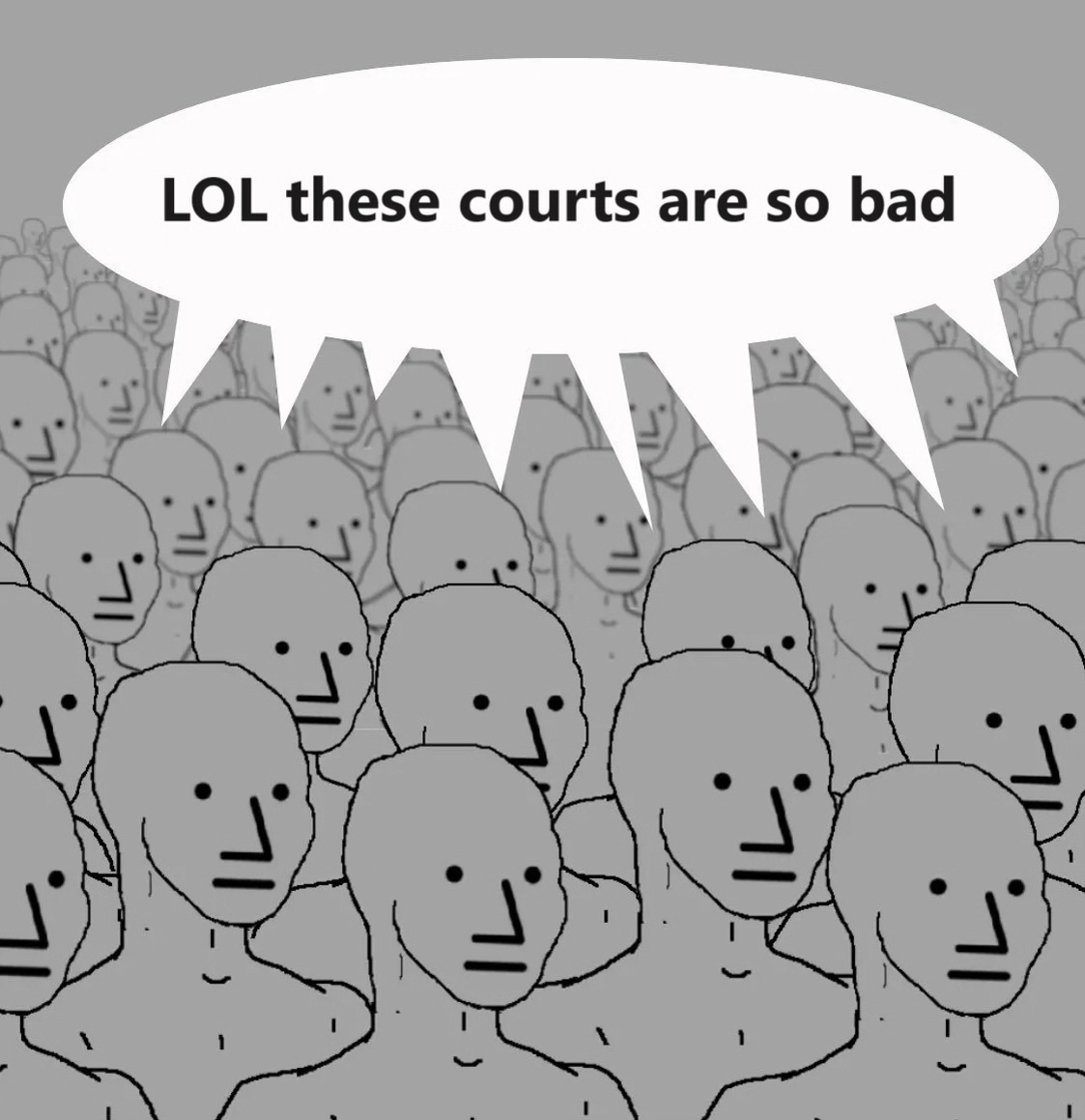Everybody talking about the NBA online last Friday night was talking about the courts. Yes, the courts.
If you didn’t watch the games on Friday, it’s likely surprising to hear that the courts were hottest topic. They became the hottest topic because unprecedented and gaudy new designs were rolled out across every game. These new courts got the people talking.
Just to be clear, yes, the court designs debuted by the NBA were really bad. But I believe the NBA fully anticipated and wholeheartedly desired the visceral reactions they received. The second-order effects of implementing such egregious aesthetics prove this was not an ill-considered decision for the NBA.
The migraine-inducing courts were used, and will continue to be used, for the NBA’s new in-season tournament. Friday night, November 3rd, was the opening night of the tournament and the court designs acted as an immediate differentiating factor between these in-season tournament games and your standard nightly contest.
I, for one, was smacked in the face by the court designs. When I arrived at a restaurant for dinner, I had no idea the in-season tournament was happening (my roommate and I were both aware of the concept but assumed it started much later in the season). That quickly changed when I was immediately bombarded by an overload of firetruck red coming from all TVs showing the Chicago Bulls game. I knew something was up and discerned that this indicated the game was part of the in-season tournament. This realization then prompted me to look into what the in-season tournament entailed. While the tournament concept is quite dumb, seeing the court proved useful in forcing me to learn about it.
Later in the night, the Dallas Mavericks took on the Denver Nuggets and created the worst conglomeration of colors I have ever seen on an NBA court. Not only was the high-contrast blue and yellow Denver court wholly unpalatable, but Denver (the home team who knew what the court would look like) wore their black jerseys which further clashed with the court’s color scheme. I almost could not watch. It was awful. Everyone knew it was awful. It got the people talking.
As seen above, a skillful fan quickly designed some courts with cleaner and more soothing appearances than what the NBA unveiled. It probably took this guy two seconds to imagine what he eventually concocted: keep the known visual language of light wooden floorboards and add some colorful team-based accents inside the three point arc. These designs or something similar seem like a no brainer to implement. If the NBA wanted non-controversial and visually pleasing courts for the in-season tournament they could have easily done that. Yet, they decided instead to produce jarring and frustrating designs.
I simply refuse to believe the NBA felt these were their best designs for the courts with regards to attractiveness. There are some number of real working professionals, likely with backgrounds in graphic design, whose literal job it was to design these courts knowing their efforts would ultimately need approval from NBA executives. There’s no chance these were their best submissions in terms of creating beauty. Clearly, the chosen design template was selected because it served other purposes.
There was lots of commentary on the courts, but hardly any was positive. Here’s a guy complaining about the courts, “Seems like no one tested the viewability of these NBA court designs beforehand? They are brutal on the eyes especially when watching a game for 2+ hours on TV”. Every reply to this tweet is also complaining about the courts. Here’s some more negative feedback and mockery. However, I doubt any of these people would have voiced their opinion about the court designs if they were optimized to be widely appealing.
Or take myself for example. I saw the courts and then I researched the tournament structure. Even if I hadn’t seen a game on TV, the same progression would have likely occurred because I would have seen all the posts about the courts online and needed to dive in further. I now know not only what these fierce courts signify, but also the general premise of the in-season tournament. That would not have been the case without the zany designs. In these regards, the rollout of the courts was flawless.
The NBA knew premiering these courts would prove irksome to viewers. That was their goal, because it got the people talking about their new Big Thing.
I have highlighted other examples of this phenomenon in the past. Exhibit A. Exhibit B. In each of these cases the Thing, whether an augmented-reality golfer or a ‘free agent visit’ post, is both novel and provocative. A ton of commentary was generated about these Things compared to what I would have expected. When your Thing is irksome, people have a really hard time keeping their mouths shut. Granted, I do not think these examples were quite as conscious of decisions as what the NBA decided to do, but the premise still holds.
An example of intentional irksomeness can be found in the design of Tesla’s Cybertruck. With its boxy and dystopian appearance, it stands out significantly from other new cars. Nearly everyone online is commenting negatively on the appearance of the vehicle, but they are commenting about the vehicle nonetheless. This leads to the Cybertruck getting way more organic publicity online than almost any other car right now. In this case, I do believe the design was highly intentional in its irregularity, just like the NBA’s new courts. Whatever you think of the design, it’s distinctness is what creates all of the reactions.
The key to being intentionally irksome is that your Thing needs to seem cool, but your execution of Thing must be aggravatingly flawed. You need to be close to achieving something laudatory, while still coming up woefully short. The poor, and obviously poor, execution tortures our monkey brains. We start screaming in our heads and oftentimes to others, “Ugh I really don’t like this! Why did they do it that way? If only they could have done it this other way instead! That would have been so much better!”. Whether people are ridiculing your Thing or suggesting improvements, they are talking about your Thing and spreading it around. For anybody that encountered the in-season tournament courts, it became nearly impossible not to comment on them. I myself made numerous comments while at dinner. It was all I could think about. Regardless of the substance of the comment, every comment benefits the NBA by spreading the word about their new Thing. For the NBA, amassing a lot of commentary may be particularly useful with regards to their ongoing future TV deal negotiations as they can likely argue that fan engagement spiked with the beginning of the in-season tournament.
Creating something irksome, something that’s just not quite right, is a surefire way to drum up engagement online. When you execute on your Thing in a way that seemingly telegraphs to others that you so obviously could have done the Thing better, people will revel in and share their opinion on your supposed shortcomings. Yet while they’re giving you negative publicity, everyone ends up digesting your Thing. I have yet to see a case where the masses are able to withhold their sheep-like comments on something intentionally irksome. Everyone just wants to join in on the fun. Although I wouldn’t recommend it, being intentionally irksome has proven to be a foolproof strategy if you’re looking to create some commotion and are agnostic of its sentiment.
Good publicity is preferable to bad, but from a bottom-line perspective, bad publicity is sometimes better than no publicity at all.
- DT
Just like that everybody was talking about the in-season tournament. 4D chess from the NBA.
Thanks for reading.






